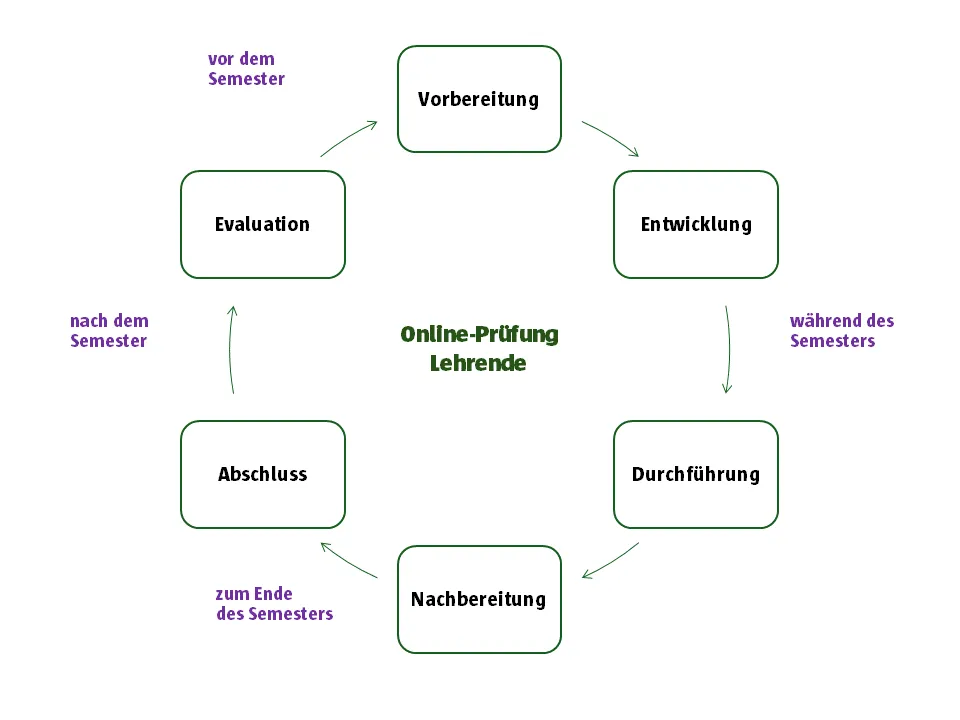Didactic Scenarios and Forms of Online Examinations
As a lecturer, you must first decide on an online examination scenario. This thematic dossier will help you with your decision and provide further tips. At the end, you will also find a series of good practice examples of online exams that your colleagues at the University of Applied Sciences Potsdam have already successfully implemented.
Didactic scenarios and forms for online exams
There are three standardised online examination scenarios and forms, which are also anchored in the framework regulations for studies and examinations at the University of Applied Sciences Potsdam. Various online examination forms are presented in more detail below. The criteria and categories are based on the general categories for examinations by Gabi Reinmann (May 2014): "Prüfungen – einfach in der Kategorisierung – komplex in der Ausgestaltung".


E-exam (presence)
Profile
- Exam form: Written exam
- Examination mode: Written from the student's perspective, examiners in a reading role, “written work” as the subject of the examination
- Examination scenario: in on-site presence, with examination supervision, examination fixed time and place, virtual, students on-campus, teachers on-campus, synchronous, centralized
- Social form: usually individual
- Resources: usually closed book, i.e. no external resources may be used
- Medium: Moodle Exam (Moodle Tests), internet, computer/laptop, video camera, possibly cell phones, students on-campus (computer pool, pop-up, BYOD), lecturers off- or on-campus (service devices)
- Purpose: knowledge recognition, reproduction, application, etc.
- Context: usually based on lecture/seminar, Moodle online course and literature

E-exam (distance)
Profile
Type of examination: Written exam
- Examination mode: written from the student's perspective, examiners in a reading role, “written work” as the subject of the examination
- Examination scenario: in virtual presence, with online conference system Zoom for video supervision, examination fixed time and place, virtual, students off-campus, lecturers off- or on-campus, synchronous, centralized
- Social form: usually individual
- Resources: usually closed book, i.e. no external resources may be used
- Medium: Moodle Exam (Moodle Test), internet, computer/laptop, video camera, possibly cell phones, students usually off-campus (BYOD), lecturers off- or on-campus (service devices)
- Purpose: performance assessment, testing of large cohorts, knowledge recognition, reproduction, application, testing of basic knowledge
- Context: usually based on lecture/seminar, Moodle online course and literature

Open book exam (distance)
Profile
- Type of examination: Written exam
- Examination mode: written from the student's perspective, examiners in a reading role, ‘written work’ as the subject of the examination
- Examination scenario: on-site presence, with exam supervision, exam scheduled for a specific time and place, with printed task sheets and answer sheets for marking, students on campus, teachers on campus, synchronous, centralized
- Social form: usually individual
- Resources: usually closed book
- Medium: For teachers only: Moodle Exam (Moodle Tests), internet, computer/laptop, students on campus (document-proof ballpoint pen with black or dark blue ink, student ID number), teachers on campus (PC and projector if necessary)
- Room: Any room will do; it does not need to be equipped with technical devices. Tables and chairs are sufficient.
- Purpose: performance assessment, testing of large cohorts, knowledge recognition, reproduction, application, testing of basic knowledge
- Context: knowledge recognition, reproduction, application, etc.

Paper-Pencil-exams (presence)
Profile
- Exam form: Written exam
- Examination mode: Written from the student's perspective, examiners in a reading role, “written work” as the subject of the examination
- Examination scenario: in on-site presence, with examination supervision, examination fixed time and place, virtual, students on-campus, teachers on-campus, synchronous, centralized
- Social form: usually individual
- Resources: usually closed book, i.e. no external resources may be used
- Medium: Moodle Exam (Moodle Tests), internet, computer/laptop, video camera, possibly cell phones, students on-campus (computer pool, pop-up, BYOD), lecturers off- or on-campus (service devices)
- Purpose: knowledge recognition, reproduction, application, etc.
- Context: usually based on lecture/seminar, Moodle online course and literature
